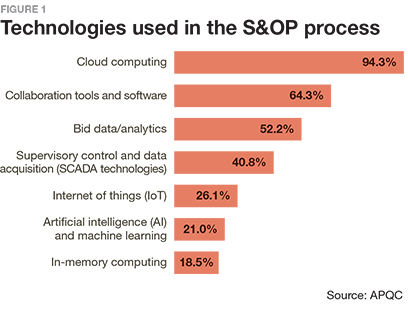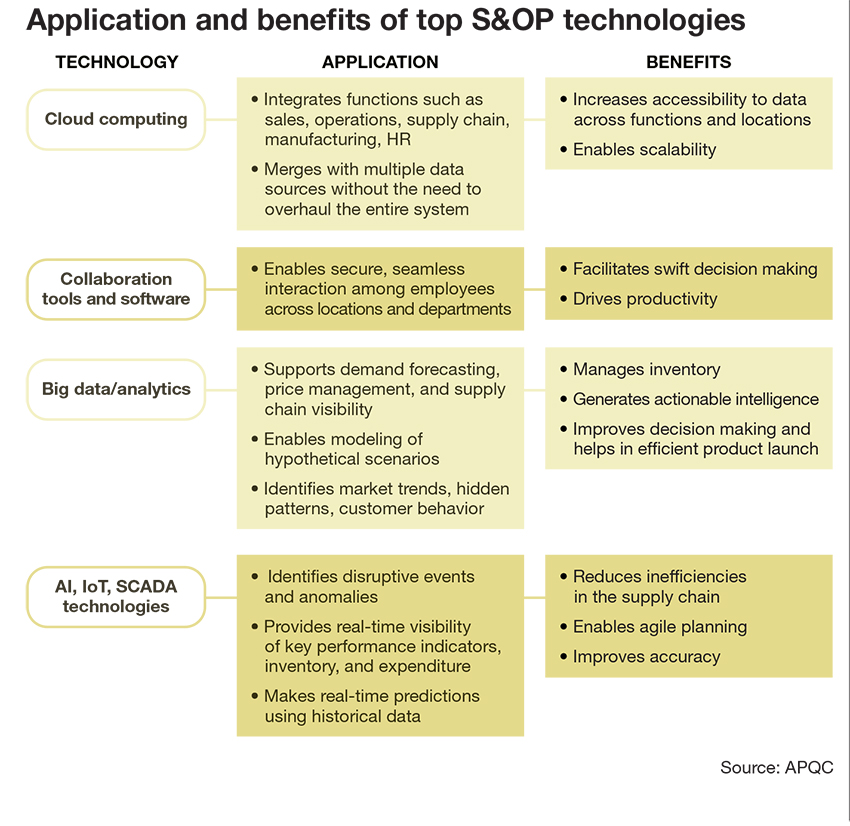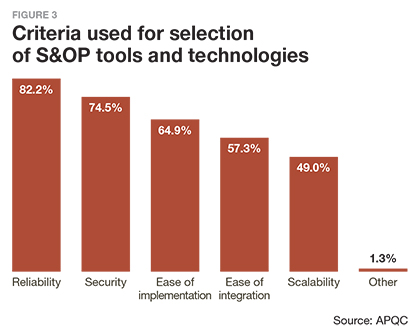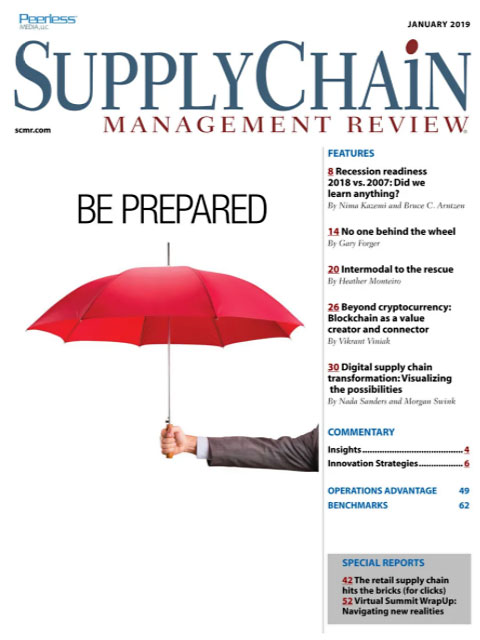Sorry, but your login has failed. Please recheck your login information and resubmit. If your subscription has expired, renew here.
January-February 2019
Truth be told, I was not a Boy Scout, or at least not a very good scout and not for very long. But I think there are some lessons for supply chain managers in the Scout motto: Be prepared. When I Wiki’d it this morning, I found the following: Be prepared, which means you are always in a state of readiness in mind and body to do your duty. Browse this issue archive.Need Help? Contact customer service 847-559-7581 More options
The sales and operations planning (S&OP) process enables synchronization in supply chain management by integrating an organization’s supply, demand and new product plans. Once the process is implemented, organizations have one operating plan to allocate resources such as time, money and employees. This enables leaders to ensure that the plans of the involved business functions are consistent and support overall corporate objectives. It also enables
organizations to better respond to both supply chain and operational challenges.
With the availability of greater amounts of data from functions involved in S&OP, organizations are increasingly turning to technology to support the S&OP process. These technologies enable the sharing of real-time data across functions and lead to more accurate and detailed planning. APQC recently surveyed S&OP professionals on how their organizations conduct the S&OP process. It also conducted cross-industry research on how organizations can leverage technology to improve S&OP.
In its research, APQC found that organizations plan to invest more in technology to support the S&OP process. However, many organizations are just now expanding their use of technology beyond spreadsheets, with the most popular tool being Cloud computing. A truly robust S&OP effort needs both technology to support data integration as well as a process supported by internal stakeholders.

This complete article is available to subscribers only.
Log in now for full access or start your PLUS+ subscription for instant access.
SC
MR
Sorry, but your login has failed. Please recheck your login information and resubmit. If your subscription has expired, renew here.
January-February 2019
Truth be told, I was not a Boy Scout, or at least not a very good scout and not for very long. But I think there are some lessons for supply chain managers in the Scout motto: Be prepared. When I Wiki’d it this… Browse this issue archive. Access your online digital edition. Download a PDF file of the January-February 2019 issue.The sales and operations planning (S&OP) process enables synchronization in supply chain management by integrating an organization's supply, demand and new product plans. Once the process is implemented, organizations have one operating plan to allocate resources such as time, money and employees. This enables leaders to ensure that the plans of the involved business functions are consistent and support overall corporate objectives. It also enables organizations to better respond to both supply chain and operational challenges.
With the availability of greater amounts of data from functions involved in S&OP, organizations are increasingly turning to technology to support the S&OP process. These technologies enable the sharing of real-time data across functions and lead to more accurate and detailed planning. APQC recently surveyed S&OP professionals on how their organizations conduct the S&OP process. It also conducted cross-industry research on how organizations can leverage technology to improve S&OP.
In its research, APQC found that organizations plan to invest more in technology to support the S&OP process. However, many organizations are just now expanding their use of technology beyond spreadsheets, with the most popular tool being Cloud computing. A truly robust S&OP effort needs both technology to support data integration as well as a process supported by internal stakeholders.
See the APQC Infographic: Key Technologies Support a Robust S&OP Process.
Technology adoption and application
Nearly 70% of the respondents in APQC's survey of S&OP professionals consider technology to be an extremely critical or very critical part of their organization's S&OP process. This is reflected in organizational plans for the future: Over two-thirds of the respondents say that their organization intends to spend more on S&OP tools and technologies in the coming years than they have in the previous year.
However, about 37% of respondents state that their organization is just starting to use S&OP tools other than spreadsheets—an indicator that many companies have a lot of ground to cover in terms of technology. For these organizations, spending more on tools and technologies for the S&OP process is a necessity. Any technology upgrade will require an investment. Those organizations that have embraced more advanced technology show that there are plenty of options available.
 APQC's research shows that Cloud computing is the most widely used, followed by collaboration tools and software (Figure 1). To a lesser extent, organizations have adopted the use of Big Data and analytics and supervisory control and data acquisition (SCADA technologies). Fewer organizations are making use of the Internet of things (IoT), artificial intelligence (AI) or in-memory computing.
APQC's research shows that Cloud computing is the most widely used, followed by collaboration tools and software (Figure 1). To a lesser extent, organizations have adopted the use of Big Data and analytics and supervisory control and data acquisition (SCADA technologies). Fewer organizations are making use of the Internet of things (IoT), artificial intelligence (AI) or in-memory computing.
As shown in Figure 2, each type of technology has its own applications, as well as its own benefits to offer an organization. Cloud computing, the most widely adopted technology, enables companies to connect data sets from their various business functions. This gives a collaborative view of processes across the enterprise, while enabling organizations to create meaningful action plans.
Although currently adopted by fewer organizations, the use of Big Data and analytics has much to offer the S&OP process. Organizations must handle an ever increasing amount and variety of data from internal sources, plus data from partners and customers. Accounting for these different data sets requires organizations to have greater processing power and tools to analyze the data and facilitate decision making. Advantages of analytics tools include the ability for organizations to create hypothetical scenarios, as well as the ability to understand supply and demand trade-offs and the financial implications of data from both internal and external sources.
AI, IoT and SCADA technologies are business intelligence and blockchain tools. AI in particular is able to address data from various internal and external sources and decode signals from both the structured and unstructured data available. This technology can then incorporate the data into projections, resulting in improved accuracy and decreased variance in S&OP processes. Business intelligence tools give functions the ability to view information in a format that aligns with the organization's S&OP reporting requirements. These technologies provide drill-down analysis, which supports more accurate decision making. They can also evaluate specific metrics such as forecast volatility and accuracy, demand consumption, supply chain liabilities, inventory management and expenditures.
Technology criteria and barriers
Although each of the technologies included in APQC's survey can benefit the S&OP process, organizations consider various factors when determining which technology they adopt. As shown in Figure 3, the top criteria organizations use when selecting tools is reliability, followed by security and ease of implementation.

These results align with the need for technology to perform consistently as well as detect inconsistencies in data. To keep costs down and minimize disruption to internal processes, organizations need technology that can integrate with existing tools and avoid the need for replacing entire systems. Organizations also need technology that is consistent across interfaces and prevents the unauthorized access of data. To ensure broad and proper use, technologies and tools must be easy enough to adopt that end users have the chance to grow accustomed to the new tools.
 However, organizations face real barriers to implementing new technology for S&OP. APQC's survey of S&OP professionals revealed that over 37% consider budget constraints and a lack of consensus to be the two largest barriers to adopting new S&OP tools. Budget constraints are often mentioned when it comes to the possibility of investing in new technology. What this often means is the technology is seen as not worth the investment. Organizations can create consensus for a new tool by considering its reliability, security and ease of implementation, as well as its potential benefit for the S&OP process. The organization can then revisit the budget to determine whether it can accommodate the tool.
However, organizations face real barriers to implementing new technology for S&OP. APQC's survey of S&OP professionals revealed that over 37% consider budget constraints and a lack of consensus to be the two largest barriers to adopting new S&OP tools. Budget constraints are often mentioned when it comes to the possibility of investing in new technology. What this often means is the technology is seen as not worth the investment. Organizations can create consensus for a new tool by considering its reliability, security and ease of implementation, as well as its potential benefit for the S&OP process. The organization can then revisit the budget to determine whether it can accommodate the tool.
Technology supports a robust process
Organizations vary in the degree to which they have adopted technology to support S&OP. APQC's research indicates that some are just moving beyond the use of spreadsheets, while others have adopted the use of Cloud computing, big data and analytics, among others. These organizations can benefit from integrating technology into an S&OP process, but the key is to first establish the robust process.
Some organizations are moving beyond basic S&OP to adopt integrated business planning (IBP), or advanced S&OP, which extends internal coordination in creating business plans. These organizations get data from functions across the enterprise, such as marketing, operations, supply chain, research and development, finance, HR and IT. The broader data collection enables them to better manage risk and quickly respond to change, all while maintaining efficient business processes. According to APQC's research, about 15% of organizations currently use IBP across the enterprise. The use of data from across so many divisions necessitates sophisticated technology to support decision making, but the first step for these organizations was the decision to adopt more in-depth S&OP processes.
Organizations should investigate the use of technology to support S&OP, but they will get the most benefit with input from different functions. Without buy-in and participation from across the enterprise, the organization will not be able to make the best business decisions that consider all relevant data. Those companies only just moving past spreadsheets can begin the adoption of technology as they gain consensus and adjust budgets. They can then scale up the process as they improve their capabilities.
About APQC
APQC helps organizations work smarter, faster and with greater confidence. It is the world's foremost authority in benchmarking, best practices, process and performance improvement and knowledge management. APQC's unique structure as a member-based nonprofit makes it a differentiator in the marketplace. APQC partners with more than 500 member organizations worldwide in all industries. With more than 40 years of experience, APQC remains the world's leader in transforming organizations. Visit us at apqc.org and learn how you can make best practices your practices.
SC
MR


Latest Supply Chain News
- How S&OP provides the answer to in-demand products
- AI, virtual reality is bringing experiential learning into the modern age
- Humanoid robots’ place in an intralogistics smart robot strategy
- Tips for CIOs to overcome technology talent acquisition troubles
- There is still work to do to achieve supply chain stability
- More News
Latest Podcast

 Explore
Explore
Software & Technology News
- AI, virtual reality is bringing experiential learning into the modern age
- Humanoid robots’ place in an intralogistics smart robot strategy
- Tips for CIOs to overcome technology talent acquisition troubles
- Game on: Rethinking change management for the digital era
- Predicting stockouts: Enhancing FMCG resilience through data-driven insights
- Top Performers Investing in, Benefitting from AI
- More Software & Technology
Latest Software & Technology Resources

Subscribe

Supply Chain Management Review delivers the best industry content.

Editors’ Picks






